Looked at your garage floor lately? Concrete takes a beating and might benefit from a covering to keep it looking good and help it last longer (not to mention taking on new uses, such as a sport court while the car is out running errands). What are we talking about? Coatings and coverings that lend a new life and give a new look to your garage floor.
Above: The floor in the Rainbow Rock Garage by Balance Associates has a steel trowel finish and was clear sealed. Take a Tour of the Balance Associates Garage. Photograph by Steve Keating via Balance Associates.
Why consider anything beyond your standard-issue concrete garage floor?
- It is wise to protect concrete from the harsh chemicals and mysterious liquids that leak out of your automobile. Even the water, salt, and snow your car drags in can promote deterioration and cracking. This is especially true in cold weather climates.
- Many flooring options are easier to keep clean than concrete. Untreated concrete gives off dust, so coating or covering it reduces dust. It prevents materials–not only from cars, but also from your other garage-based activities (gardening, building, painting)–from soaking into the porous concrete.
- Flooring can cover up existing cracks for looks, safety, and protection.
- Garage flooring options can be more forgiving to dropped objects (tools and sports equipment). If your garage doubles as a workspace, garden shed, or art studio, your body will benefit from standing on something softer than concrete.
- There are aesthetic considerations. Coverings and coatings are available in a variety of colors, textures, and patterns. And, the concrete that was gorgeous when the floor was installed may not be so attractive with oil or other stains that develop.
- New flooring might open up new activities in your garage. It could double as a sport court or workout space while the car is out.
Above: The floor in a garage by Bay Area architect Cathy Schwabe is scored concrete slab coated with a heavy duty epoxy sealer to make cleaning up easier and to prevent penetration of oil and other materials. “It has held up well, and one can even clean up the leaking oil from these two old cars and have it looking new again,” says Schwabe. Photograph by David Wakely.
What are the options for garage flooring?
Our research suggests that the options fall into two categories: coating and covering. Deciding on the right approach depends on how you plan to use the garage, your objectives (looks or protection), the current state of the concrete floor, and cost considerations.
Coating
The most common options are paint and epoxy, though new generation coatings are making their way from industry to residential use. Before you consider applying any sort of coating, it is important to check your garage floor for moisture. Coatings need to be applied to dry and temperate concrete or they will not adhere properly (think peeling and puckering). Another benefit of coatings is that you can add non-slip materials and color or texture additives into the mix. Talk to your contractor or coating supplier to determine the requirements for the material of your choice.
Above: Applying paint to a garage floor is relatively easy and inexpensive. Photograph via Garage Retreat.
Garage Floor Paint: Possibly the least expensive solution (all it requires is a few cans of paint and labor), painting is a quick way to upgrade the look of your floor. Painting is primarily an aesthetic approach to garage floor enhancement as it does not stand up to chemicals and wear and tear as long as other coatings. The two most commonly used types of paint are acrylic latex or an epoxy. Both will provide some protection (though not as much as other options) against mold, mildew, and moisture. Epoxy paint is tougher against chemicals and lasts slightly longer, and is priced higher as a result. Regardless of the material used, a concrete primer coat is recommended for to provide better bonding.
Above: Behr Premium 1-Part Epoxy Concrete and Garage Floor Paint in silver gray is $31.98 for a gallon at Home Depot.
Textural Treatments and Clear Coating: What do we mean by textural treatments? Polishing, scoring, and acid-staining to name a few. Concrete can be scored or stamped to look like tiles, large or small. Acid-staining has also become popular. Something to have professionally done, this process uses chemistry to stain concrete with irregular almost-fluid looking patterns in a range of natural colors. Sealing the concrete after such treatments is recommended to add shine and a protective overlay for the finish.
Above: This acid-washed scored concrete flooring almost mimics the look of weathered wooden boards.
Polishing concrete and adding a clear sealer dresses up, protects and prolongs the life of a standard concrete floor. A clear acrylic sealer provides a clear protective layer, not as durable as epoxy, but more than naked concrete, and adds a bit of refined shine. One gallon of Tuf-Top Silicone Acrylic Water-Repellent Concrete Sealer is $38.31 at The Paint Store.
Epoxy: A very popular choice that is used in auto showrooms and professional garages (not to mention restaurant kitchen floors), epoxy is a tough coating that resists oil stains, beads water, and cleans easily. It is highly resistant to chemicals, chipping and scuffing. Essentially liquid plastic that is coated on top of the concrete, it offers a glossy finish that many find appealing. With installation, the cost runs close to $3 per square foot.
Beyond projects that involve a glue gun, I am not a DIYer and would only consider using a professional for something as long lasting and with durability requirements as garage floor coatings. For those with a serious DIY proclivity, epoxy-coating your garage floor is said by some to be as easy as painting. See This Old House’s “How to Epoxy-Coat a Garage Floor” for detailed instructions.
Above: A shiny gray epoxy-coated garage floor by Espace Garage+.
Polyurethane-Based Coatings: Polyurea (related to Polyurethane) floor coatings long used in industry have become a new option for garage floors. A resin-based coating like epoxy, Polyurea cures faster and in a wider variety of conditions (but only by professionals!). It is a no-VOC substance that, unlike epoxy, is UV resistant, so it won’t discolor or fade. These added benefits also bring a higher price tag than epoxy flooring.
Above: A Polyurea-coated garage floor. Photograph via Mad Stone Floors.
Coatings of all types are not a great choice for garages that contend with high moisture issues. Nor are they a good way to go on an already severely cracked floor (think adherence issues). In these situations, and when your budget is tight, consider the wide variety of floor coverings that lay on top of your existing concrete.
Coverings
Garage floor coverings in the form of mats and tiles are an easy-to-install way to create a durable and attractive flooring surface. Available in several materials including rubber, vinyl, and polypropylene.
Above: Interlocking floor tiles used in different colors help define the parking from working zones in this garage by Harrison Architects. See more of this Green Topped Garage.
Garage Floor Tiles: Designed to withstand the weight and liquids generated by cars, modular tiles are a quick way to cover up and protect a concrete floor. The majority of the tiles on the market are made of plastic, but you can also find rubber (not as durable), steel (for a car showroom look–we are not going in that direction), and stone (because of the cost and the concerns with grout, we don’t list it in our selections). Available in a wide variety of colors, tiles can be used to create patterns or a solid color surface that is easy to clean and durable. Different surface options include diamond scoring, raised coin-like dots, smooth, and ribbed. Another benefit is the cushioning they provide for those standing in a garage for extended time periods. Priced from $3 to $5 per tile, the square foot cost is higher than some coating options.
Above: Installing garage floor tiles is fast and easy thanks to interlocking joints that snap together.
Above: Racedeck Circle Track Tiles measure 1-foot sqaure and are available in ten colors; $49.99 for a set of 12 at Hayneedle.
Above: Swisstrax offers Recycled Rubber Flooring Tiles (available only in black). Contact Swisstrax for pricing and ordering information.
Garage Floor Mats: Rubberized vinyl floor mats are a very easy and effective way to cover your concrete floor, contain liquids from your car, and create a clean and comfortable flooring option. The mats can be purchased in a variety of sizes, from a large mat that just fits one standard car, to mats that interlink to cover an entire garage floor surface.
Above: Flexible and easy to roll out, the Diamond Deck Roll Out Flooring Mat is available in a variety of sizes (that can be used together for large surfaces) and requires no installation other than rolling out on the floor; $217.95 for the 7-by-14 foot size (other sizes available) at Amazon.
Indoor/Outdoor Carpet: We are not talking about your 1970’s garage-turned-rec-room shag carpet, rather heavy duty outdoor carpet that can withstand elements and weight.
Above: Flor Working Class Carpet Tile is made of polypropylene in a dense, flat and coarse weave that will stand up to use in a garage. Each 19.7-inch square is $10 ($3.72 per square foot). Available in tan (as shown), light gray, and dark gray.
Thinking of transforming your garage into something other than car storage? Get inspired by A Garage Turned Garden Pavilion and Garage as Garden Shed.




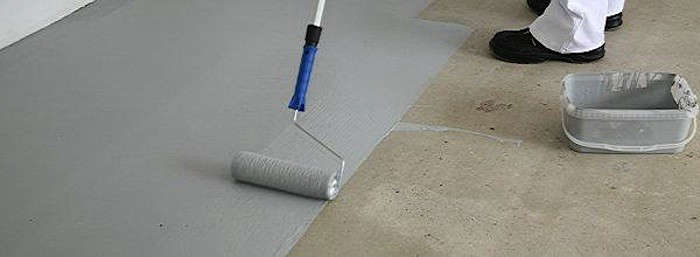

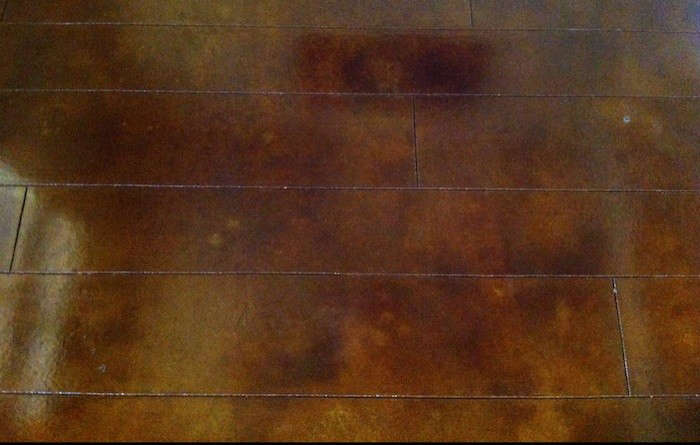


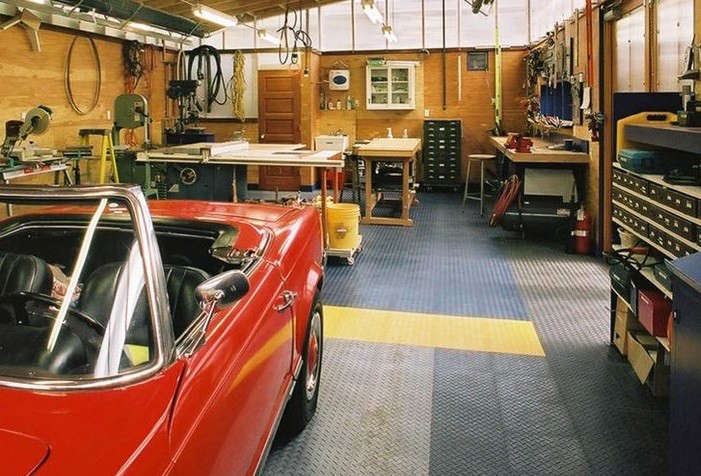

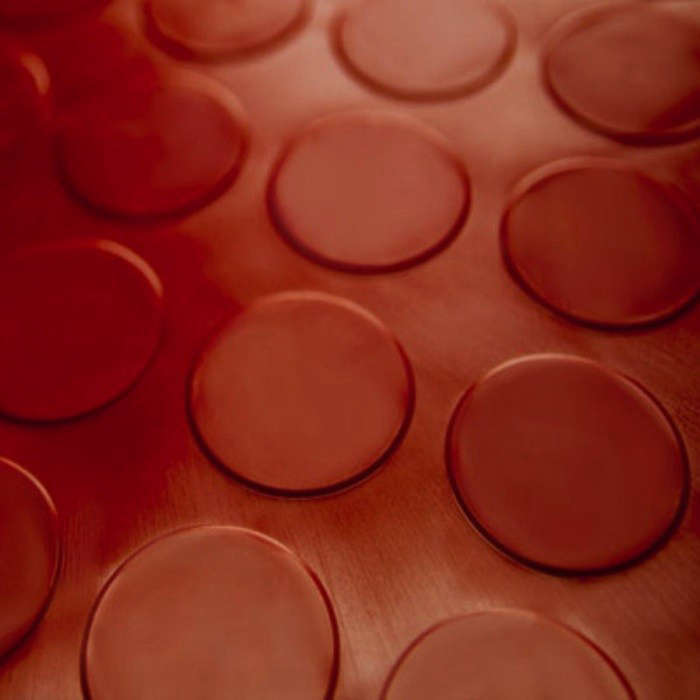
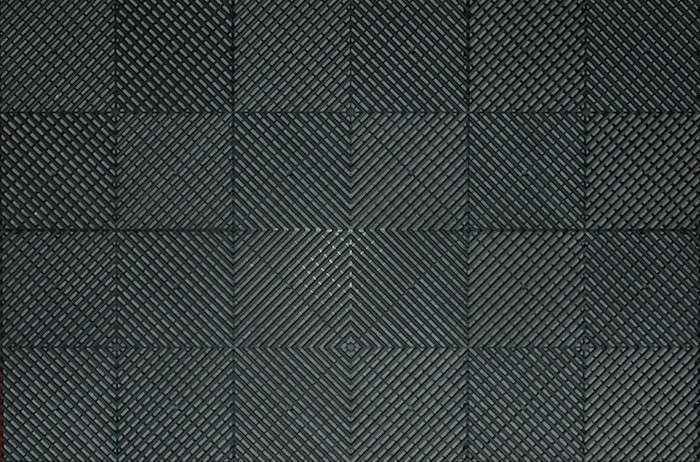

















Have a Question or Comment About This Post?
Join the conversation (5)